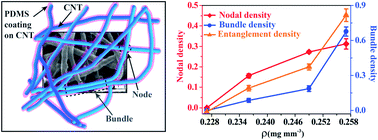Tailored viscoelasticity of a polymer cellular structure through nanoscale entanglement of carbon nanotubes†
Abstract
A three-dimensional carbon nanotube (CNT) cellular structure presents a unique revelation of microstructure dependent mechanical and viscoelastic properties. Tailored CNT–CNT entanglement demonstrated a direct impact on both the strength and viscosity of the structure. Unlike traditional foams, an increase in the CNT–CNT entanglement progressively increases both the strength and the viscosity. The study reveals that an effective load is directly transferred within the structure through the short-range entanglements (nodes) resulting in an enhanced mechanical strength, whereas the long-range entanglements (bundles) regulate the energy absorption capacity. A three-dimensional structure of entangled CNT–CNT shows ∼15 and ∼26 times enhancement in the storage and loss moduli, respectively. The higher peak stress and energy loss are increased by ∼9.2 fold and ∼8.8 fold, respectively, compared to those of the cellular structures without entanglement. The study also revealed that the viscoelastic properties i.e. the Young's modulus, stress relaxation, strain rate sensitivity and fatigue properties can be modulated by tailoring the CNT–CNT entanglements within the cellular structure. A qualitative analysis is performed using finite element simulation to show the impact of CNT–CNT entanglements on the viscoelastic properties. The finding paves a way for designing a new class of meta-cellular materials which are viscous yet strong for shock absorbing or mechanical damping applications.



 Please wait while we load your content...
Please wait while we load your content...